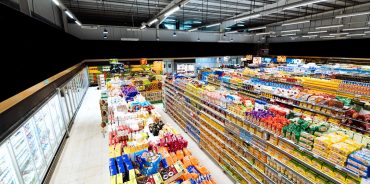The five trends shaping the future of CPG Brand advertising
Around the world, dunnhumby works with more than 1,000 consumer packaged goods brands, giving us deep insight into the issues that influence their advertising strategies. In this post, Stuart Campbell – Insight Director at dunnhumby UK – explores five of the most significant trends, and what they might mean for the future of brand advertising.
- Changing shopper behaviours have made agility increasingly vital
From panic buying to changing the way that we celebrate the holidays, Covid’s impact on our shopping behaviours has been pronounced. And though most of these trends have been relatively short-lived, one in particular has stayed the course: the growth in online.
Over the past two years, retailers have seen an unprecedented surge in demand for online grocery. Naturally, many brands and agencies have increased their spend on digital retail marketing in kind, seeking to reach out to that greatly expanded audience.
While many shoppers have chosen to stick with online[1], others have reverted to pre-pandemic habits and returned to stores[2]. That presents a huge headache for advertisers, who have little way of knowing for sure where they should be allocating their spend as behaviours continue to shift.
The vital attribute needed to deal with this challenge is agility: brands and agencies will need to manage their spend on an omnichannel basis, using retailer-generated insight in order to react swiftly to new shopping trends.
- Brands need to work their online spend harder than ever
Shoppers might be heading back to stores, but that doesn’t mean that online sales will return to pre-Covid levels. Online grocery was already on an upward trend before the pandemic hit, and around two-thirds of people who started shopping the channel during the outbreak continue to do so today[3]. There’s little doubt that we’re now beyond the tipping point in terms of utilisation.
While that presents CPGs with a bigger addressable audience, it also means that they’re facing increased competition to reach the right people. Spend on digital retail marketing is expected to rise by 66% in the UK by the end of this year[4], while US-based brands are on track to up their digital ad spending by around 32%[5].
As Brands continue to funnel their media spend towards digital channels – specifically retailer-owned ones – they’ll need to ensure that their investments are working as hard as possible. That, in turn, will mean having greater clarity about the audiences they’re targeting and the tactics they employ – as well as the certainty that those choices are delivering genuine impact.
- The line between “digital” and “shopper” marketing is continuing to blur
Once upon a time, there was digital marketing and there was shopper marketing, and rarely the twain would meet. Each of the two was a different discipline, required a unique skillset, and would be managed by a separate team.
That’s no longer the case. The rise of retailer-owned media networks has driven a dramatic shift away from “traditional” digital advertising into retail marketing; Amazon’s now 10% share of the digital ad market comes at Google’s expense, for instance[6]. As that transition continues, the line between what constitutes digital and shopper marketing is growing increasingly thin, with both sides looking to those networks to help them meet their objectives.
This new era is undoubtedly going to require closer collaboration between these teams. Moreover, it will require digital and shopper marketers – as well as their agencies – to have a better and more coherent view of each other’s budgets, goals, and spend, ensuring that the focus is on maximum impact rather than fragmented activity.
- Retail Marketing will offer Brands the post-cookies insights they need
Google may have delayed its ban on third-party cookies until 2023, but that change is still coming. When it does, advertisers will find themselves unable to implement audience targeting and frequency capping for some 99% of Chrome users (or around two-thirds of the world’s internet traffic[7] based on current browser adoption).
While Google is – naturally – working on a replacement solution that will go at least some of the way to restoring the audience targeting capabilities it offers today, it’s clear that digital advertisers need to prepare for digital disruption over the coming few years.
One of the major advantages offered by retail marketing is that it gives brands the ability to tap into loyalty and purchasing data. With the right approach, they can reach highly specific audiences in a way that’s genuinely additive to the shopping experience – making shopper faster and more convenient, all while enhancing the effectiveness of their advertising.
- Zero-based budgeting means that accountability is everything
“If you can’t guarantee that it’s going to work, don’t do it.” That’s the premise on which zero-based budgeting is founded, and we’ve seen an increasing trends towards the tactic as brands seek to minimise wasted ad spend in the wake of a disruptive couple of years.
While it’s a solid concept in principle, zero-based budgeting can also be difficult to employ effectively. The retail marketing ecosystem is fragmented, and measurement and modelling methodologies can vary wildly from system to system and network to network. Understanding what actually works has become no small task.
As the advertising world continues to push towards a no-risk approach to spend, the challenge for brand and agency marketing teams will be to demonstrate the full impact of their efforts; not just in terms of exposure or intent, but in quantifiable, consistent sales as well.
References
[1] Increased use of online grocery shopping ‘here to stay’ – Supermarket News, 25 August 2021
[2] Online grocery shopping declines as customers head back to stores – Meat Management, 17 August 2021
[3] Source: dunnhumby Consumer Pulse Wave 7
[4] Who’s really driving the increase in retail media? – The Drum, 26 April 2021
[5] US retail, CPG, and entertainment industries drive nearly 47% of all digital ad spending in 2021 – Insider Intelligence, 28 July 2021
[6] Amazon Surpasses 10% of U.S. Digital Ad Market Share – The Wall Street Journal, 6 April 2021
[7] The end of third-party cookies: How it will affect advertisers and publishers – Marketing Tech, 20 April 2021
TOPICS
The latest insights from our experts around the world
The factors underpinning AI’s success
Learning from the leaders: lessons in best practice from Europe’s winning hypermarkets
dunnhumby’s Global Partner Summit: five things we learned about personalisation and loyalty




